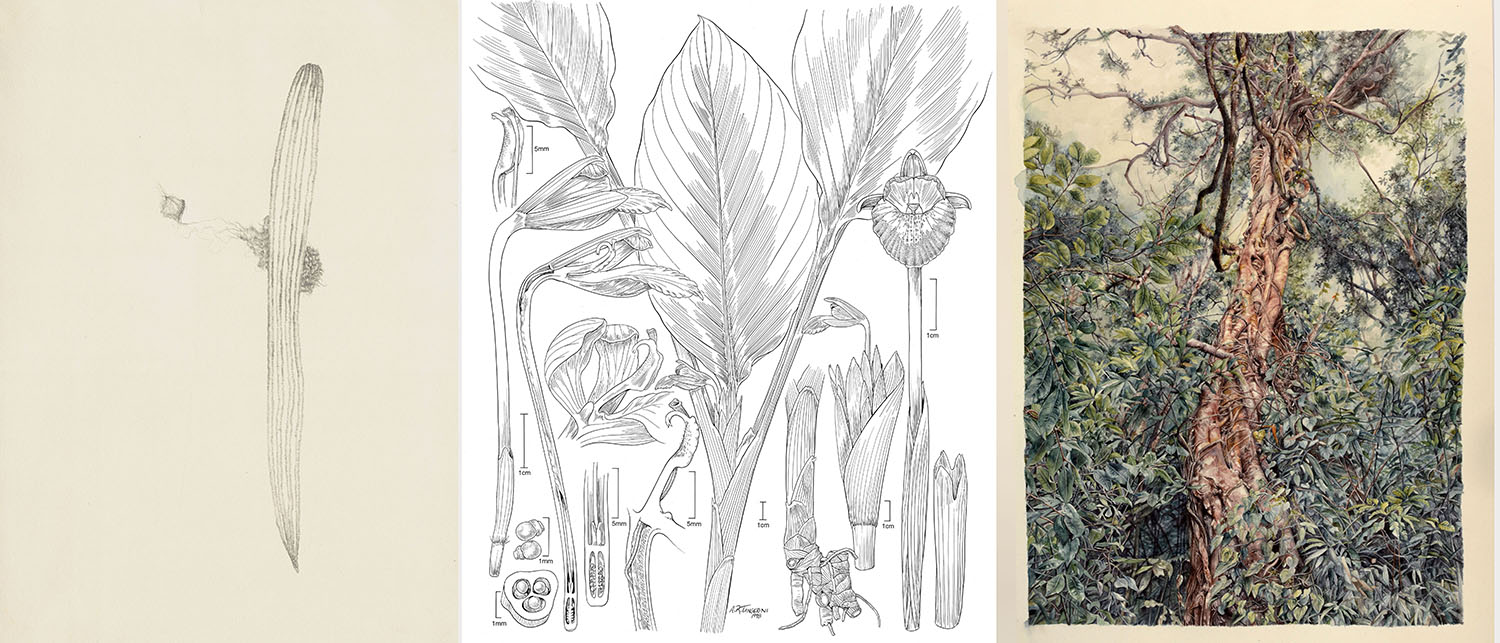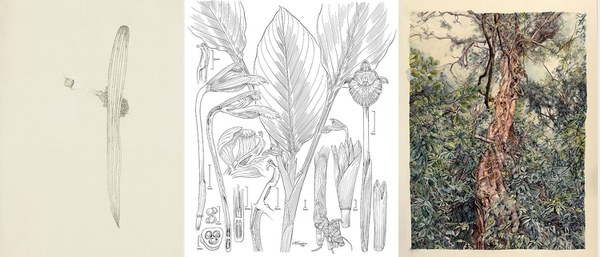Botany has always been a highly visual science, and women artists and illustrators have played a key role in the creation and dissemination of botanical knowledge. While the exhibition’s narrative begins in the seventeenth century, this panel brings together three contemporary artists and illustrators who are engaging with and transforming the tradition of botanical representation. As scientific illustrator for the National Museum of Natural History, Alice Tangerini has worked closely with botanists and illustrated over one thousand species of plants in scientific literature. She shares the methods of creating her information-rich pen-and-ink drawings, and the changes in scientific illustration brought by the digital age. Nirupa Rao is a botanical artist from Bangalore, India, who works closely with scientists and conservationists to document the extraordinary biodiversity of the Western Ghats. Her goal is to educate the public in environmentalist practices both through initiatives on the ground and her multiple publications. Temitayo Ogunbiyi is an artist and curator who moves between the US, Jamaica, and Nigeria. Following a residency at the Smithsonian in 2018, Ogunbiyi has created a series of botanical drawings on herbarium paper that engage with natural history collections and the historical practices that underlay their formation. The panel discusses the varied artistic processes employed by these three practitioners to explore the scientific, aesthetic, historical, and environmental interests that inform their work.
Panelists
Temitayo Ogunbiyi’s art practice moves between drawing, painting, sculpture, and installation, responding to and forging dialogues between global current events, anthropological histories, and botanical cultures from her perspective as a Nigerian-Jamaican-American. Systems that capture, mediate, and direct the movement of people, information, and matter are recurring subjects of investigation in her practice. In 2018, Ogunbiyi built her first functional playground, appropriating construction materials and conventional household items into a composition of nonprescriptive stimuli. The artist has made four functional playgrounds to date. Ogunbiyi is the recipient of several fellowships and awards, including a 2020–2021 Digital Earth Fellowship, a 2018 Smithsonian Artist in Research Fellowship, and a 2014 Ford Foundation Fellowship. Her artwork has been exhibited at the Madre Museum (Naples, Italy), the 2019 Lagos Biennial, the Pulitzer Foundation for the Arts, the Centre for Contemporary Art Lagos, the Museum of Contemporary African Diasporan Arts (Brooklyn, New York), the Perm Museum of Contemporary Art (Perm, Russia), a curatorial publication for the 10th Berlin Biennale, the Fries Museum (Berlin), and the 2nd Lagos Biennial. She lives and works in Lagos, with her young family.
Nirupa Rao is a botanical illustrator based in Bangalore, India. Her work is inspired by regular field visits into the wild and informed by close collaboration with natural scientists to achieve accuracy. As a National Geographic Young Explorer, Rao received a grant to create her book Hidden Kingdom: Fantastical Plants of the Western Ghats (2019). She has also published Pillars of Life: Magnificent Trees of the Western Ghats (2018), a debut project in collaboration with naturalists Divya Mudappa and T. R. Shankar Raman of the Nature Conservation Foundation. She illustrated the cover of Amitav Ghosh’s latest novel, Gun Island, and rejacketed four of his older novels for Penguin Random House. In collaboration with conservationist Krithi Karanth, Rao also created illustrations for educational games that are used in wildlife conflict–prone schools in rural India. This year, the initiative will reach four hundred schools, helping children live in harmony with the natural world. In 2019, she participated in a Plant Humanities summer program at Dumbarton Oaks. She has also been named an INK Fellow, one to “watch out for” in Forbes India’s annual “30 Under 30” issue, and one of Harper’s Bazaar India’s “Indian Women to be Proud Of.” In 2020, she received the prestigious National Geographic Storytelling Fellowship.
Alice Tangerini, staff illustrator for the Botany Department at the Smithsonian’s National Museum of Natural History, has been specializing in drawing plants since 1972. She works with pen and ink, graphite, and—recently—digital color. She has illustrated over one thousand species of plants appearing in scientific periodicals, floras, and botanical and nature books. Tangerini teaches classes in illustration techniques, presents lectures on botanical illustration, and juries shows in botanical gardens and academic institutions. Her responsibilities in the Botany Department also include managing and curating an extensive collection of botanical illustrations. In 1999, Tangerini received the Distinguished Service Award from the Guild of Natural Science Illustrators. In 2008, she was honored with the Excellence in Scientific Botanical Art award from the American Society of Botanical Artists, of which she is a past board member. In 2020, the Linnean Society of London honored Tangerini with the Jill Smythies Award for outstanding illustrations that portray diagnostic characteristics.

